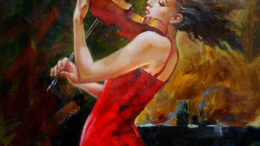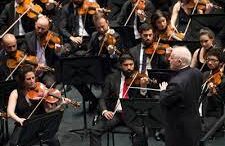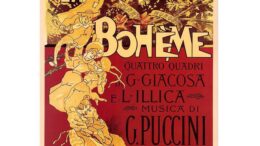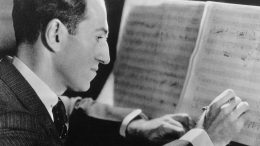By Michael Laster July 6, 1957, could have been another ordinary day in Liverpool. However, a band called The Quarrymen was performing for a festival right outside of St Peter’s Church. The young man leading the group, John Lennon, caught the attention of a young onlooker, also a musician, who was impressed by Lennon’s stage presence, in spite of him singing the wrong words. A mutual friend introduced John to this young man, who tuned John’s guitar and performed two songs for him. Unlike John, he memorized all the words and knew all the chords. This was John Lennon’s introduction to Paul McCartney. John, initially hesitant of being overshadowed, invited Paul into the band a few weeks later. Needing a lead guitarist, Paul brought in a younger acquaintance who was just shy of 15. This was George Harrison, who Paul befriended after overhearing him practicing guitar on the school bus. Several months after George joined the band, a friend with a tape recorder captured them singing the Buddy Holly song, “That’ll be the Day,” and an original by Paul titled “In Spite of All the Danger.” The title of the song would prove to be all too relevant. Several days after In Spite of All The Danger was recorded, John’s mother Julia was killed after she was struck by a car driven by an off-duty policeman. Having grown up with an absent father, 17-year-old John was devastated losing the one parent he was close with, and went through a period of social withdrawal. Paul also lost his mother from breast cancer before meeting John. He remembered, “So this was a great bond John and I always had. We both knew the pain of it, and we both knew that we had to put on a brave face because we were teenage guys, and you didn’t talk about that kind of thing where we came from.” Needing a bassist, John recruited his friend Stu Sutcliffe, whom he met at the Liverpool College of Art. Around this time, they officially changed their name from the Quarrymen to The Beatles. Their informal manager Alan Williams booked them to play several months in Hamburg’s Reeperbahn, its famous red light district. Needing a drummer, they recruited their friend Pete Best, the son of the owner of a cafe they frequently performed in. In Hamburg, more than any other time in their career, this would be The Beatles at their wildest and raunchiest, the polar opposite of their future clean cut Ed Sullivan image. This experience playing Hamburg was invaluable for developing their musicianship and stage presence, often having to play eight-hour sets, mostly of covers of well known hits. Back in Liverpool, they continued to build a following at the Cavern Club, playing gigs there regularly. Stu Sutcliffe quit the band to focus on his art career, so Paul stepped in to take over on bass. At the Cavern, they caught the eye of Brian Epstein, a local record store owner and music enthusiast. Their on stage energy and charisma led Brian to propose a meeting with them at his record shop, where he offered to become their manager. Weeks later, they agreed to sign Brian’s contract. John Lennon, being 21, signed for himself with the other three, under 21, requiring a signature from a parent. 1962 After arranging an unsuccessful audition at Decca Records, Brian brought the Beatles to George Martin, a producer at Parlophone Records, a subsidiary of EMI. Initially, Martin wasn’t very impressed with their musicianship, but signed them largely on their charisma. Martin found Pete Best’s skills on drums lacking, preferring a session drummer for recordings. This aligned with John, Paul, and George’s growing dissatisfaction with Best, so they asked Brian to replace him with Richard Starkey, known as Ringo Starr. He was a Liverpool favorite from the band Rory Storm and the Hurricanes, and had occasionally played with the Beatles in Hamburg and Liverpool. He’s a clip of them performing a cover of the song Some Other Guy at the Cavern, just days after bringing in Ringo. By the end of the year, their single Love Me Do, and their B side, P.S. I Love You, helped push the Beatles to get the attention of the UK. 1963 It wasn’t until 1963 that The Beatles reached #1 on the UK charts with their song Please Please Me, also the title of the album of the same name. 1963 was their breakout year in the UK, and they followed it with other catchy hits like From Me to You, She Loves You, I Saw Her Standing There, and I Want To Hold Your Hand. Their on-stage charisma was punctuated by the yin and yang dynamic of Paul being diplomatic and professional, and John clowning around. *clip* By the end of the year, Beatlemania was now in full swing throughout the UK, and the British classical music critic William Mann was praising their gifts for writing sophisticated melodies and harmonies. Also, by the end of the year, their music was starting to reach America. 1964 In 1964, the Beatles literally reached America, landing at JFK airport on February 7th. President Kennedy was assassinated just four months earlier, and their appearance on The Ed Sullivan Show was watched by 73 million viewers, 40% of the US population. Months later, they played themselves in the feature film A Hard Day’s Night, where director Richard Lester captured the height of Beatlemania. Alun (Alan) Owen wrote the screenplay, accurately portraying their whimsical personalities. Their album A Hard Day’s Night, written while filming the movie, presented a new level of sophistication of their arrangements. Paul’s Latin-tinged ballad, And I Love Her, demonstrates their growing attention to detail, featuring claves, bongos, and a Spanish guitar. *clip* The album also helped popularize the 12-string electric guitar, which would prove quite influential to Roger McGuinn of the Byrds. You can hear the same jangly guitar sound in their covers of Pete Seeger’s song Turn Turn Turn, and Bob Dylan’s Mr. Tambourine Man. After the success of A Hard Day’s Night, they continued breaking new ground with their single, I Feel Fine. It opens with the first use of guitar amplifier feedback on a record. Originally an accident, the Beatles loved the sound and asked George Martin if he’d allow it into the recording, which he did. This was the first of many experiments in the studio. 1965 1965 opened with the recording of their hit Ticket To Ride, defined by the jangly 12-string guitar. Their next movie, and album, Help!, was their first to use orchestral instruments. You’ve Got To Hide Your Love Away features flute, and the only instruments on Yesterday are Paul’s acoustic guitar and a string quartet. From this point forward, George Martin played a key role in helping to write the arrangements for parts outside of the scope of standard rock instrumentation. Their next single, We Can Work It Out, written by Paul, features a harmonium, and the bridge deviates from the march-like rhythm into a waltz, the first time they changed what’s known as the meter in a song. Their next album, Rubber Soul introduced a host of musical innovations. John’s tune, Norwegian Wood, features George Harrison on sitar for the first time, which he bought after seeing one on the set of Help!. George’s song Think For Yourself features Paul on two bass parts – one of them standard, and the other featuring the bass through a fuzz pedal. The song Girl, written by John, contains an interlude written by Paul featuring two acoustic guitars harmonizing together in their upper register, allegedly influenced by the sound of the bouzoukis from the soundtrack of the film Zorba the Greek. One of the most important innovations of Rubber Soul was the keyboard solo for John’s poignant classic, In My Life. John asked George Martin to write something Baroque sounding for the middle of the song, so Martin ended up composing a Bach-like interlude. It proved too fast to play at full speed, so Martin ended up playing it an octave lower at half speed, then sped up the recording to double the speed, returning it to its original octave. This accidentally resulted in it sounding much brighter, like a harpsichord. 1966 It’s worth noting that around this time, they were experimenting with heavier drugs than the uppers and downers they were introduced to in Hamburg, or the marijuana they were introduced to by Bob Dylan. John, George, and their wives had their drinks spiked with LSD by their dentist John Riley at a dinner party a year earlier. By 1966, all 3 Beatles had taken it except for Paul, with John using it the most often. Paul started experimenting with it towards the end of 1966. It’s impossible to know exactly how much this drug was responsible for the artistic landmarks to come. Making use of the newest studio technology was inherently exciting for them, in addition to their competitive streak with other bands like the Beach Boys, the Rolling Stones, and The Who. Considering their track record of innovation, even without LSD, they would probably still be at the creative forefront of the 1960s counterculture. Their next single, Rain, the B-side of Paperback Writer, showcased their new embrace of psychedelia, featuring an Indian-influenced drone on the guitars throughout. Most noteworthy is the ending where John’s lead vocals are replayed backwards. Like the use of feedback in I Feel Fine, or sped up piano in In My Life, or the use of the sitar in Norwegian Wood, this was a first in rock music. At this point, they had fully mastered the art of writing catchy songs. Now they were ready to infuse their music with surprise and experimentation that not only delighted, but challenged their listeners. Their next album, Revolver, pushed the boundaries of what a rock record could be. In fact, the album’s second track, Eleanor Rigby, has no rock instruments at all. It consists only of vocals accompanied by a string octet, which was masterfully arranged by George Martin, partially inspired by Bernard Herrmann’s score to Psycho. Continuing their new found love of reverse-tape loops, I’m Only Sleeping includes a backwards guitar solo, helping to reinforce the idea of being in the state between waking and sleeping. George’s composition Love You To from Revolver was their most Indian influenced song to date, featuring not only sitar, but other instruments like tabla and tambura. For No One features a clavichord, and a French Horn. Yellow Submarine, a children’s song written by John and Paul for Ringo to sing, showcases a number of sound effects depicting life aboard this imaginary submarine, including bubbles, waves, rattling chains, clinking glasses, and a marching band. Revolver was also significant for having Paul’s bass more prominent in the mix, showcasing his sophisticated countermelodies that were essential to each song. The closing track, Tomorrow Never Knows, is the most experimental and psychedelic song of the album. It features a variety of altered tape loops, played backwards, sped up, or both. John intended to evoke “a thousand Tibetan monks chanting on a mountain”. While the Beatles get credit for coming up with such inventive ideas, their sound engineer Geoff Emerick was often the one who had to figure out how to implement them on a practical level. A week or two before Revolver was released, an old interview with John from earlier in the year was reprinted in the US. In the interview, he claimed, “Christianity will go. It will vanish and shrink. I needn’t argue about that; I’m right and I will be proved right. We’re more popular than Jesus now; I don’t know which will go first – rock ‘n’ roll or Christianity.“. These comments were largely uncontroversial in the UK. However, in the US, especially among conservatives in the South, the comments were seen as downright blasphemous. In fact, The Beatles were already unpopular among many conservatives because of their public stances in favor of civil rights and against the war in Vietnam. John tried to clarify that the quote was taken out of context. Despite this, the backlash continued. Several southern radio stations organized bonfires encouraging fans to burn copies of their records, and members of the Ku Klux Klan openly threatened them. During a concert in Memphis, an audience member threw a firecracker onto the stage. Out of concern for their safety and a desire to keep evolving in the recording studio, they decided to stop touring for good. All three but Paul were already married, with John and Ringo being fathers. They were now ready to fully let go of the Fab Four image marketed towards teenage girls, in favor of a more mature, artistic direction. Three months later, now with mustaches and goatees, they were back at Abbey Road studios to record John’s new song, Strawberry Fields Forever. The song famously opens with an introduction played by Paul on mellotron, a synthesizer-like keyboard that here imitates the sound of flutes. George Martin arranged the orchestral track, which featured four trumpets, three cellos, and the Indian swarmandal. The song is filled with backwards effects, and is the product of pasting together two takes in different keys at different speeds. John favored these two particular takes, and asked George Martin to do what he could to make them work together. Martin accomplished this highly unorthodox task by slowing one down and speeding up the other so the difference is imperceptible. The song is considered one of the most experimental, sophisticated, and influential songs in rock music history. Those previously isolated in the world of classical music were now finally paying attention. 1967 The Beatles sustained this creative momentum into their next album, Sgt. Pepper’s Lonely Hearts Club Band. The album broke new ground in terms of what a rock album could be, and is their best selling album, having sold over 30 million copies. One song fades into the next, creating a sense of continuity from beginning to end. George Martin played an essential role on this album, arranging the orchestral instrumentation throughout, like the clarinets on When I’m 64, the strings and harp on She’s Leaving Home, and the brass band for the title track. For George Harrison’s composition, Within You Without You, classical strings were seamlessly combined with traditional Indian instrumentation. The most innovative song on the album, however, was the closing track, A Day in the Life. The reflective, outer sections were written by John, with a contrasting, cheerful middle section written by Paul. But between the two sections, and at the ending, there’s a 20-second passage featuring a 40-piece orchestra. John and Paul wanted something that would “sound like the end of the world,” so George Martin directed the orchestra to slide from their lowest note to their highest over 24 bars, creating a dramatic build-up. The song ends with a single E chord that lasts for a full 40 seconds, played by several pianos. Sgt Pepper represents the band at their peak as innovators. Their next single, All You Need Is Love, was released in 1967 at the height of the Summer of Love. While there’s plenty to say about the song musically, such as the many quotes from classical music and jazz during the ending fade out, it was the first song ever to be recorded in the studio live on TV. Later that summer, their manager Brian Epstein’s life was cut short at 32 from an accidental overdose of sleeping pills and alcohol. They were clearly shaken by the news. They decided not to replace him, and to manage themselves. With psychedelia still in the air, they began their next project, Magical Mystery Tour. Like A Hard Day’s Night and Help!, this would be their third album that was tied to a movie. It was broadcast by the BBC and was a complete flop. Critics considered it amateurish and lacking any coherent narrative, but Paul criticized the BBC for airing it in black and white, thus depriving viewers of the full visual experience. Paul’s song, The Fool on the Hill, is a standout on the album. It features a quirky recorder, played by Paul, and three flutes, arranged by Martin. John’s absurdist, I Am The Walrus, was partly inspired by Lewis Carrol’s poem, The Walrus and the Carpenter. The song fades out over a radio broadcast of King Lear. 1968 George, in addition to learning sitar with Ravi Shankar, was now a devoted meditator and practitioner of Hinduism. He persuaded his bandmates to come with him to India, where they learned transcendental meditation from Maharishi Mahesh Yogi. Their experience was mixed, but they returned back to London with over 30 new songs, which provided the material for two albums worth. The double album is simply called The Beatles, commonly referred to as The White Album. The songs represent a departure from their psychedelic phase, and ranges from folky acoustic tracks like Julia, Blackbird, and Mother Nature’s Son, to edgy rockers like Helter Skelter, Back In The USSR, and George’s classic, While My Guitar Gently Weeps. This song features Eric Clapton on lead guitar. George brought Clapton in for his skill, but also hoping it would clear some of the growing tension within the band. Paul, being self-taught on bass, drums, piano, and guitar, got into the habit of recording his tracks by himself. George was frustrated with being limited to two songs per album in spite of his clear growth as a songwriter. And John’s new love interest, the avant-garde artist, Yoko Ono, was sitting in on all the sessions, which broke the unspoken “no partners in the studio” rule. After coming home early from a vacation in Greece, John’s wife, Cynthia, found John and Yoko together, with Yoko wearing her bathrobe. Cynthia immediately moved out with their son Julian, and filed for divorce shortly after. During these White Album sessions, Paul wrote the single Hey Jude to comfort John’s son Julian, originally calling it Hey Jules. It became the best selling single of the second half of their career, and is an example of the tail wagging the dog. The repeating chant of the song’s ending goes on longer than the rest of the song! Later that year, the animated film Yellow Submarine was released. It featured a combination of new songs and old songs, and an orchestral score composed by George Martin. The Beatles’ speaking roles were voiced over by actors, though they do briefly appear in person for the closing song, All Together Now. 1969 The goal of their next major album, Let It Be, was to return to their roots by recording their songs together, as a band, unlike much of the White Album. George brought the young, talented Billy Preston to sit in on keyboard. Billy’s presence lifted the vibe immediately. The album was released in May of 1970, along with a film documenting the making of the album, even though most of the recording took place in January of 1969. This includes their famous final concert, which took place on the roof of Apple Records. Eventually the police were called in to stop the concert, but this only helped to solidify their continued desire to be seen as counter-cultural rebels. In February of 1969, they hired Allen Klein to help sort out the band’s business and financial concerns. But their decision wasn’t unanimous. Paul distrusted Klein, but was outvoted by the other three. Their next project was their iconic album Abbey Road. It features two of George Harrison’s most beloved songs: The ballad, Something, and Here Comes The Sun. It was now more apparent than ever that he had found his voice as a mature songwriter, and many consider these two songs the strongest of the album. However, Abbey Road’s boldest experiment is the medley at the end, consisting of eight short songs performed without pause. This helped to recreate the tight continuity they pulled off on Sgt Pepper. George Martin played a key role in shaping the flow of the medley. It begins with Paul’s song You Never Give Me Your Money, inspired by his dissatisfaction with Klein as a manager. Unfortunately, shortly after Abbey Road was recorded, John announced he was leaving the band to focus on his solo projects with Yoko. The other Beatles, knowing John could sometimes be impulsive, weren’t sure whether this was permanent or temporary. John’s departure wasn’t publicized because Klein needed the Beatles to appear united to negotiate a new contract with Capitol Records for higher royalties. 1970 Eventually, their united front finally fell apart when Paul publicly announced his departure from the Beatles. This was due to his dissatisfaction with Klein as a businessman, the final straw being Phil Spector’s lush orchestral overdub of the Long and Winding Road. The others liked how it sounded, but Paul despised it. He angrily demanded that Klein remove Spector’s contribution, but Klein ignored him; copies of the album were already being printed. Feeling like he could lose creative control over his songs under Klein’s management, Paul was forced to take up the ugly task of suing his bandmates to dissolve the partnership. Years after the breakup, the other Beatles admitted that Klein was indeed a conman, and that Paul was right about him. After the Beatles, they all enjoyed successful solo careers, which (will be covered in future programs.) (are covered in separate programs.) Unfortunately, the 4 Beatles would never officially reunite. Tragically, on December 8th, 1980, John was fatally shot outside of his apartment building by a lone gunman. Many Beatles fans who lived through this event are still in shock, including Paul, who claimed that he’s partially still in denial. However, in the mid-90s, the three remaining Beatles did reunite as part of the Anthology documentary. They collaborated on finishing two of John’s unfinished home demos, Real Love, and Free As A Bird, produced by Jeff Lynne. Several years later, in 2001, George died from cancer as he was putting the finishing touches on his final album, Brainwashed. A memorial concert was filmed a year later, called Concert For George, which featured many of his collaborators and friends, including Paul, Ringo, Eric Clapton, Ravi Shankar, and George’s son, Dhani. In 2023, Paul, Ringo, and George Martin’s son Giles, completed another one of John’s demos, Now and Then. The song soon reached number 1 on the UK and US charts. The Beatles continue to hold the place of best-selling artist of all time, having done what very few get the historical opportunity to do, or have the vision to accomplish. Namely, they mastered the formulas of pop music, and then, after having the world’s attention, made their songs into timeless works of creative expression. As they evolved in the studio, they invited the public to evolve with them, as listeners.














































